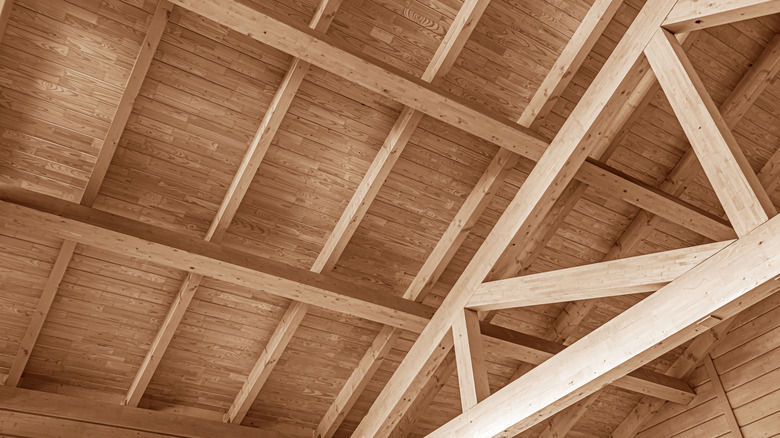How To Know If Your Porch Can Hold The Weight Of A Swing
Porches can do more than just add equity to a home; they also enrich our lives and connect our families. According to a 2021 survey by PR Newswire, 74% of Americans frequently use their outdoor spaces for relaxation, and 54% depend on their porches to host guests and socialize with loved ones. Adding a swing to your porch is a great way to give it a warm and welcoming appearance and inject a little fun into your outdoor space. After all, who doesn't dream about sipping cold lemonade or watching the kids play as they rock back and forth in the summer breeze? But before your swinging dreams come crashing down, make sure your porch ceiling can actually support the weight of a swing! The vast majority of porches have support beams called ceiling joists, and a typical two-person swing should only be attached to ceiling joists that can support at least 500 pounds.
But how do you know how much weight your joists can hold? It all depends on their size and how many ceiling joists you have. Here's what you need to know to determine the weight limit of your porch ceiling joists and other factors to consider before you install a porch swing.
Assess your ceiling joists
Porch swings should always be attached to joists in the ceiling, never the ceiling or roof itself. Depending on the size and number of ceiling joists you have, your porch may or may not be able to support a porch swing. Most porch swings themselves weigh less than 50 lbs., but of course, you aren't just going to admire them from afar. If you plan on actually using your porch swing, your ceiling needs to be able to support the weight of the swing in addition to the people using it. An average two-person porch swing has a weight limit of about 550 pounds, but the exact limit will vary by swing size and model.
Joists are the sturdy horizontal wood beams that follow the roofline of your porch, supporting the weight of the roof and ceiling. If you have a finished porch, the joists may be hidden behind ceiling panels. To carry the weight of an average two-person swing, your porch ceiling will need to have at least one 2 x 8 joist, two 2 x 6 joists, or three 2 x 4 joists. When in doubt, it's best to attach your swing to at least two joists to help evenly distribute the load.
Consider swing placement and other options
Before installing your swing, identify the size of joists you have on your porch ceiling. You may need to use a stud finder to locate the joists if they're hidden behind ceiling panels. If your joists are smaller than 2 x 8, you'll need to position your swing in a way that it can hang from multiple joists. In addition to considering the weight of your swing, you'll need to plan out sufficient room to properly install and use the swing. Individual models will vary, but most swings need about 50 inches of space in front of and behind them and about 16 inches of space on either side. This will give you enough wiggle room to walk around the swing and sit on it without bumping into nearby walls or railings. Even if your swing seems safe and strong, avoid overcrowding the swing and rock gently to reduce strain on the chains and hooks.
If you've determined that your joists aren't strong enough to hold a swing, you still have a few options. One option is to install more boards into the ceiling to add support, known as "sistering" or "blocking." If that seems like a lot of work, consider hanging two one-person swings on separate joists instead of one two-person swing. Alternatively, you can get the same dreamy swing-like vibe on your porch from a rocking bench, a hanging chair with a hook stand, or a hammock.


